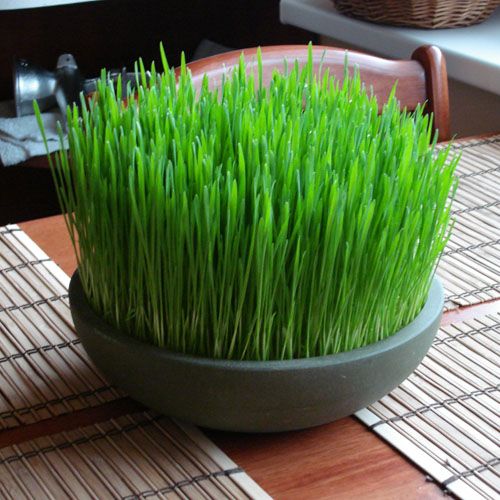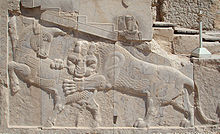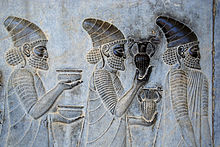
| NOWRUZ AND ARYANS 
Growing wheatgrass is one of the most common traditional preparations for Nowruz Nowruz is the Iranian New Year, also known as the Persian New Year, which is celebrated worldwide by various ethno-linguistic groups.
Despite its Iranian and Zoroastrian origins, Nowruz has been celebrated by diverse communities. It has been celebrated for over 3,000 years in Western Asia, Central Asia, the Caucasus, the Black Sea Basin, and the Balkans. It is a secular holiday for most celebrants that is enjoyed by people of several different faiths, but remains a holy day for Zoroastrians, Bahais, and some Muslim communities.
Nowruz is the day of the vernal equinox, and marks the beginning of spring in the Northern Hemisphere. It marks the first day of the first month (Farvardin) of the Iranian calendar. It usually occurs on March 21 or the previous or following day, depending on where it is observed. The moment the Sun crosses the celestial equator and equalizes night and day is calculated exactly every year, and families gather together to observe the rituals.
The
first day of the Iranian calendar falls on the March equinox, the
first day of spring, around 21 March. In the 11th century CE the
Iranian calendar was reformed in order to fix the beginning of the
calendar year, i.e. Nowruz, at the vernal equinox. Accordingly,
the definition of Nowruz given by the Iranian scientist Tusi was
the following: "the first day of the official New Year [Nowruz]
was always the day on which the sun entered Aries before noon."
Nowruz is the first day of Farvardin, the first month of the Iranian
solar calendar.
To download Nowruz prayer written in English, Farsi and Gujarati Click here.
Timing Accuracy :
Illumination of the Earth by the Sun on the day of equinox Nowruz's timing in Iran is based on Solar Hijri algorithmic calendar, which is based on precise astronomical observations, and moreover use of sophisticated intercalation system, which makes it more accurate than its European counterpart, the Gregorian calendar.
Each 2820 year great grand cycle contains 2137 normal years of 365 days and 683 leap years of 366 days, with the average year length over the great grand cycle of 365.24219852. This average is just 0.00000026 (2.6×10-7) of a day shorter than Newcomb's value for the mean tropical year of 365.24219878 days, but differs considerably more from the mean vernal equinox year of 365.242362 days, which means that the new year, intended to fall on the vernal equinox, would drift by half a day over the course of a cycle.
Charshanbe Suri :
Charshanbe Suri. In Iran, it is celebrated on the eve of the last Wednesday before Nowruz. It is usually celebrated in the evening by performing rituals such as jumping over bonfires and lighting off firecrackers and fireworks.
In Azerbaijan, where the preparation for Novruz usually begins a month earlier, the festival is held every Tuesday during four weeks before the holiday of Novruz. Each Tuesday, people celebrate the day of one of the four elements – water, fire, earth and wind. On the holiday eve, the graves of relatives are visited and tended.
Iranians sing the poetic line "my yellow is yours, your red is mine" to the fire during the festival, asking the fire to take away ill-health and problems and replace them with warmth, health, and energy. Trail mix and berries are also served during the celebration.
Spoon banging is a tradition observed on the eve of Charshanbe Suri, similar to the Halloween custom of trick-or-treating. In Iran, people wearing disguises and go door-to-door banging spoons against plates or bowls and receive packaged snacks. In Azerbaijan, children slip around to their neighbors' homes and apartments on the last Tuesday prior to Novruz, knock at the doors, and leave their caps or little basket on the thresholds, hiding nearby to wait for candies, pastries and nuts.
The ritual of jumping over fire has continued in Armenia in the
feast of Trndez, which is a feast of purification in the Armenian
Apostolic Church and the Armenian Catholic Church, celebrated forty
days after Jesus's birth.
History and origin :
Ancient roots :
Bas-relief in Persepolis, depicting a symbol in Zoroastrianism for Nowruz There exist various foundation myths for Nowruz in Iranian mythology.
The Shahnameh credits the foundation of Nowruz to the mythical Iranian King Jamshid, who saves mankind from a winter destined to kill every living creature. Jamshid may symbolise the transition of the Proto-Iranians from a hunter-gatherer lifestyle to animal husbandry and a more settled life. To defeat the killer winter, Jamshid constructed a throne studded with gems. He had demons raise him above the earth into the heavens; there he sat, shining like the Sun. The world's creatures gathered and scattered jewels around him and proclaimed that this was the New Day (Now Ruz). This was the first day of Farvardin, which is the first month of the Iranian calendar.
Although it is not clear whether Proto-Indo-Iranians celebrated a feast as the first day of the calendar, there are indications that Iranians may have observed the beginning of both autumn and spring, respectively related to the harvest and the sowing of seeds, for the celebration of the New Year. Mary Boyce and Frantz Grenet explain the traditions for seasonal festivals and comment: "It is possible that the splendor of the Babylonian festivities at this season led the Iranians to develop their own spring festival into an established New Year feast, with the name Navasarda "New Year" (a name which, though first attested through Middle Persian derivatives, is attributed to the Achaemenian period)." Since the communal observations of the ancient Iranians appear in general to have been seasonal ones, and related to agriculture, "it is probable that they traditionally held festivals in both autumn and spring, to mark the major turning points of the natural year."
Nowruz is partly rooted in the tradition of Iranian religions, such as Mithraism and Zoroastrianism. In Mithraism, festivals had a deep linkage with the Sun's light. The Iranian festivals such as Mehrgan (autumnal equinox), Tirgan, and the eve of Chelle ye Zemestan (winter solstice) also had an origin in the Sun god (Surya). Among other ideas, Zoroastrianism is the first monotheistic religion that emphasizes broad concepts such as the corresponding work of good and evil in the world, and the connection of humans to nature. Zoroastrian practices were dominant for much of the history of ancient Iran. In Zoroastrianism, the seven most important Zoroastrian festivals are the six Gahambar festivals and Nowruz, which occurs at the spring equinox. According to Mary Boyce, "It seems a reasonable surmise that Nowruz, the holiest of them all, with deep doctrinal significance, was founded by Zoroaster himself"; although there is no clear date of origin. Between sunset on the day of the sixth Gahambar and sunrise of Nowruz, Hamaspathmaedaya (later known, in its extended form, as Frawardinegan; and today known as Farvardigan) was celebrated. This and the Gahambars are the only festivals named in the surviving text of the Avesta.
The 10th-century scholar Biruni, in his work Kitab al-Tafhim li Awa'il Sina'at al-Tanjim, provides a description of the calendars of various nations. Besides the Iranian calendar, various festivals of Greeks, Jews, Arabs, Sabians, and other nations are mentioned in the book. In the section on the Iranian calendar, he mentions Nowruz, Sadeh, Tirgan, Mehrgan, the six Gahambars, Farvardigan, Bahmanja, Esfand Armaz and several other festivals. According to him, "It is the belief of the Iranians that Nowruz marks the first day when the universe started its motion." The Persian historian Gardizi, in his work titled Zayn al-Akhbar, under the section of the Zoroastrians festivals, mentions Nowruz (among other festivals) and specifically points out that Zoroaster highly emphasized the celebration of Nowruz and Mehrgan.
Achaemenid period :
A bas-relief at the Apadana, Persepolis, depicting Armenians bringing their famous wine to the king Although the word Nowruz is not recorded in Achaemenid inscriptions, there is a detailed account by Xenophon of a Nowruz celebration taking place in Persepolis and the continuity of this festival in the Achaemenid tradition. Nowruz was an important day during the Achaemenid Empire (c. 550–330 BCE). Kings of the different Achaemenid nations would bring gifts to the King of Kings. The significance of the ceremony was such that King Cambyses II's appointment as the king of Babylon was legitimized only after his participation in the referred annual Achaemenid festival.
It has been suggested that the famous Persepolis complex, or at
least the palace of Apadana and the Hundred Columns Hall, were built
for the specific purpose of celebrating a feast related to Nowruz.
Arsacid and Sassanid periods :
Nowruz was the holiday of Arsacid dynastic empires who ruled Iran (248 BCE–224 CE) and the other areas ruled by the Arsacid dynasties outside of Parthia (such as the Arsacid dynasties of Armenia and Iberia). There are specific references to the celebration of Nowruz during the reign of Vologases I (51–78 CE), but these include no details. Before Sassanids established their power in Western Asia around 300 CE, Parthians celebrated Nowruz in autumn, and the first of Farvardin began at the autumn equinox. During the reign of the Parthian dynasty, the spring festival was Mehrgan, a Zoroastrian and Iranian festival celebrated in honor of Mithra.
Extensive records on the celebration of Nowruz appear following the accession of Ardashir I, the founder of the Sasanian Empire (224–651 CE). Under the Sassanid emperors, Nowruz was celebrated as the most important day of the year. Most royal traditions of Nowruz, such as royal audiences with the public, cash gifts, and the pardoning of prisoners, were established during the Sassanid era and persisted unchanged until modern times.
After the Muslim conquest :
Nowruz, along with the mid-winter celebration Sadeh, survived the Muslim conquest of Persia of 650 CE. Other celebrations such as the Gahambars and Mehrgan were eventually side-lined or only observed by Zoroastrians. Nowruz became the main royal holiday during the Abbasid period.
Following the demise of the caliphate and the subsequent re-emergence of Iranian dynasties such as the Samanids and Buyids, Nowruz became an even more important event. The Buyids revived the ancient traditions of Sassanian times and restored many smaller celebrations that had been eliminated by the caliphate. The Iranian Buyid ruler 'Adud al-Dawla (r. 949–983) customarily welcomed Nowruz in a majestic hall, decked with gold and silver plates and vases full of fruit and colorful flowers. The King would sit on the royal throne, and the court astronomer would come forward, kiss the ground, and congratulate him on the arrival of the New Year. The king would then summon musicians and singers, and invited his friends to gather and enjoy a great festive occasion.
Later Turkic and Mongol invaders did not attempt to abolish Nowruz.
Contemporary era :
Before the collapse of the Soviet Union, Iran was the only country that officially observed the ceremonies of Nowruz. When the Caucasian and Central Asian countries gained independence from the Soviets, they also declared Nowruz as a national holiday.
Nowruz was added to the UNESCO List of the Intangible Cultural Heritage of Humanity in 2010. To commemorate the UN recognition, Iran unveiled a commemorative postage stamp during the first International Nowruz Celebrations in Tehran on Saturday, 27 March 2010.
Locality :
The festival of Nowruz is celebrated by many groups of people in the Black Sea basin, the Balkans, the Caucasus, Western Asia, central and southern Asia, and by Iranians worldwide.
Places where Nowruz is a public holiday include :
• Afghanistan
• Albania
Nowruz in Bharat (India) :
In Bharat Nowruz is celebrated but in a different way. It is dedicated to Goddess Durga.
(Lot of deities like Ishtar, Astarte, Inana, Lilith, Kadesh, Qudhu and Hathor are shown riding a lion like the Hindu goddess Durga.) There is a festival connected with Goddess Durga called Navratri where for 9 days Navratri is celebrated.
There
are 4 Navratri in a year :
4 season change is correspond to 4 navratri :
Jaya
Parvati Vrat is observed in Ashada Maas by unmarried girls and married
women in Gujarat and some other Western India parts. This vrat is
observed for five days for 5, 7, 9, or maybe even 11 years.
Here we can see the common similirities in Aryan traditions but because of the invasions and seperation of lands into different countries a lot is lost but time has now come to rebuild the lost traditions and alliances. |



